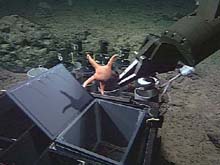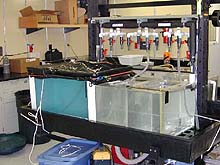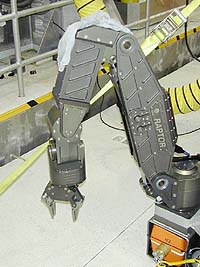
The manipulator arm on the ROV Tiburon places this sea star in a “bio box” to protect it from thermal shock on its trip to the surface. Click image for larger view.
Live Animal Collection And On-Board Maintenance
May 20, 2002
Edward Seidel, Associate Curator
Monterey Bay Aquarium
![]() Watch the ROV Tiburon collect samples from the seamount. (mp4, 5.4 MB)
Watch the ROV Tiburon collect samples from the seamount. (mp4, 5.4 MB)
In order to collect deep-sea animals and keep them alive and healthy long term, we try to recreate the environmental parameters of the deep sea environment as closely as possible in captive settings. Most of the environmental parameters--temperature, salinity, pH, oxygen saturation, et cetera--are fairly easy to control. However one parameter, pressure, is difficult to recreate in tanks. Imagine trying to pressurize a tank to 100 atmospheres? This is the equivalent of approximately 1,500 pounds per square inch (keep in mind the pressure in a car tire is about 35 psi) . Luckily for us, keeping the animals cold helps to mitigate some of the effects of loss of pressure, so many of the animals do fine in our 1 atmosphere pressure tanks.
The first step in successfully collecting an animal is having a well-trained and talented pilot, like the pilots at MBARI, to control the ROV and the robotic arm. It is not a trivial task to collect a delicate deep-sea animal with a robotic arm that is attached to a 3.75 ton ROV located 1000 meters below you and your only visual frame of reference is a two-dimensional TV monitor (remember, the ship is rocking the whole time you're trying to do this operation!)

The Western Flyer is equipped with a deluxe wet lab, complete with chilled sea water for keeping deep sea animals alive.
Click image for larger view.
Once the animal is collected, we transfer it to a thermally protected box, the “bio box.” The bio box is a simple, plastic box with a hinged lid and a polypropylene pull rope for opening and closing. When the box is closed, it keeps the animal at the temperature it was collected. That way when we bring the ROV back up to the surface through warmer water (the temperature difference between the bottom and surface can be as great as 30 degrees Farenheit) we don't “cook” the animal. On this expedition, we are also using plastic tubes with spring-loaded caps, as you'll see in the video. These serve the same purpose, and work especially well in conjunction with the suction sampler.
Once the animal is on board, we move it into a tank in the R/V Western Flyer's seawater wet lab. The lab has flowing seawater that we can set to the same temperature as where the deep-sea animal was collected. For short cruises, we typically don't feed the animals since we'll be back to shore in a short period of time and because the food can cause fouling and water quality degradation in the tanks.

The robotic arm for the ROV Tiburon has to be both powerful and dextrous to collect many different sample types. Click image for larger view.
Careful notes on animal behavior, environmental parameters (both of where the animals was collected and in captivity), photographs and video are kept to better understand how to successfully keep the animal alive for long periods of time in captivity.<
Sign up for the Ocean Explorer E-mail Update List.















